Thunderbolt 3 in Action: Akitio Thunder3 Duo Pro DAS Review
by Ganesh T S on April 14, 2016 8:30 AM EST- Posted in
- Storage
- DAS
- Thunderbolt 3
- Akitio
The Nuts and Bolts of Thunderbolt 3
In order to understand and appreciate Thunderbolt 3, it is important to look at how Thunderbolt has evolved over the last five years. Thunderbolt was launched in 2011 to provide a unified interface with enough bandwidth to satisfy virtually everything needed simultaneously in terms of external I/O and display output. The first two versions shared the same cabling and connectors as mini-DisplayPort. They essentially muxed / demuxed PCIe lanes and DisplayPort lanes over a Thunderbolt cable using Thunderbolt controllers.
At the time of its launch, Thunderbolt was facing competition from USB 3.0 which had already seen a lot of adoption on the PC side. The parallels between USB 2.0 / FireWire and USB 3.0 / Thunderbolt were difficult to ignore. Even after Thunderbolt 2 was launched (with the ability to aggregate the two discrete bidirectional 10Gbps channels in the first version of Thunderbolt), the perception remained that it was relevant only to Mac users. Despite a number of PC components with Thunderbolt 2 integrated, Windows users never found the technology to live up to its advertised potential. Common complaints included peripherals not carrying certification for use on PCs, peripherals outright not working on PCs, unreliable hot-plugging and degraded performance compared to what one could obtain with the same device in a Mac.
In 2012, Intel luanched an Ivy Bridge NUC with Thunderbolt integrated. Unfortunately, the issues cited above resulted in Thunderbolt getting completely dropped from the NUC lineup. It was a golden chance for Intel to drive up Thunderbolt adoption, but, the overall peripheral market put a spanner in the works.
Thunderbolt 3 and Type-C
While the 'Thunderbolt for PCs' market was trying to build momentum, USB-IF started to finalize the specifications for USB 3.1 that could deliver up to 10 Gbps of theoretical bandwidth. By mid-2015, the USB consortium had announced both 10Gbps “Superspeed+” USB 3.1 Gen 2 and the new USB Type-C connector, a compact, reversible connector designed to drive the standard for the next decade or more. The introduction of USB Alternate Mode functionality – the ability for USB Type-C to carry other protocols along with (or instead of) USB Superspeed data – made USB more flexible than ever. VESA had also announced that DisplayPort would be supporting alternate mode to deliver DisplayPort video over USB Type-C ports and cables.
At Computex 2015, Intel announced Thunderbolt 3. It marked a shift in the signaling layer from what was used in Thunderbolt 1 and Thunderbolt 2. This was done in order to support more bandwidth per cable. By taking advantage of USB Type-C's alternate modes (i.e, the four high-speed data lanes in the Type-C specifications), Thunderbolt 3 became a standard built on top of the USB Type-C port.
Along with the change in the cable and connectors, Thunderbolt 3 also upgraded the total available bandwidth to 40 Gbps. Thunderbolt 3 also updated the active cables with electronics at both cable ends to support full bandwidth. With the usual Type-C cables, Thunderbolt 3 drops down to 20 Gbps.
Intel also markets Thunderbolt as the 'Type-C that does it all'. It is easy to see the reason behind this.
Consumers should always check the logo next to their Type-C port in order to identify the capabilities of the port in terms of the bandwidth available, power delivery capability and DisplayPort carriage support. Intel wants to bring it across to consumers that the Thunderbolt logo encompasses all these capabilities. Readers might wonder where the USB 3.1 capabilities suggested above come from. This is where the Alpine Ridge controller comes into the picture.
The Alpine Ridge Controller
Intel's chipsets usually take a generation or two after the introduction of any I/O version update (say, SATA II to SATA III, or, USB 2.0 to USB 3.0) before getting native support for the latest version. In the meanwhile, motherboard vendors resort to third-party bridge chips that interface with the PCH using PCIe lanes to provide the latest and greatest I/Os. The same thing is happening currently with USB 3.1, and this is where Intel has found a way to sneak in Thunderbolt support into more systems.
Intel's Thunderbolt 3 controller (Alpine Ridge) also integrates its own USB 3.1 (Superspeed+) host controller, which in turn serves dual purposes. When serving as a host controller for a USB Type-C port, this allows Alpine Ridge to directly drive USB 3.1 device if they’re plugged into an Alpine Ridge-backed Type-C port (similar to how DisplayPort works today with Thunderbolt ports). And when serving as a device controller (e.g. in a Thunderbolt monitor), this allows devices to utilize and/or offer USB 3.1 ports on their end.
Given that motherboard vendors integrate a USB 3.1 Gen 2 bridge chip in most mid-range and higher products, it actually costs them only a slight premium to go in for Alpine Ridge as compared to, say, an ASMedia bridge chip which can only provide USB 3.1 Gen 2 functionality.
Thunderbolt 3 Usage Scenarios
Thunderbolt 3 enables various scenarios such as a single-cable docking solution for charging, data transfer and display output, and external discrete GPU docks with hot-plug support.
Thunderbolt Networking also allows creation of a 10 Gbps network for peer-to-peer connection between various computing systems (based on a network adapter model in the host OS).
Given Intel's lofty goals with Thunderbolt 3, and the fact that systems with the ability to act as Thunderbolt 3 hosts have been shipping since late last year, it was imperative that various Thunderbolt 3 products enabling the above usage scenarios had to come to the market soon. The credit for being the first shipping Thunderbolt 3 peripheral goes to the Akitio Thunder3 Duo Pro. Intel and Akitio shipped us a couple of units so that we could check out the capabilities of Thunderbolt 3 in practical scenarios.



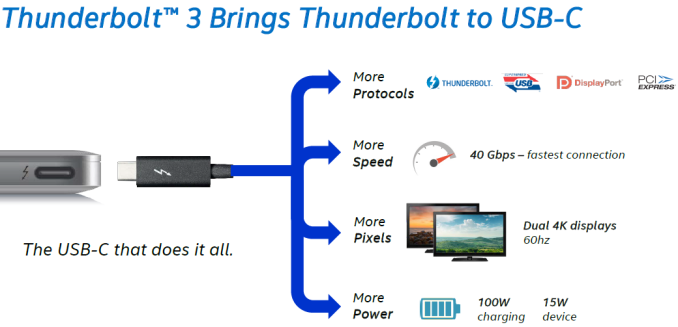
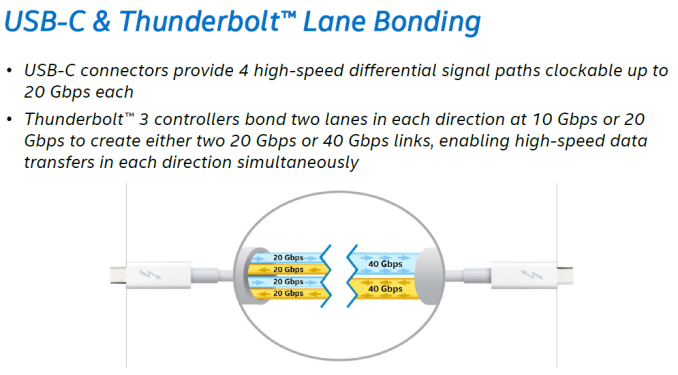
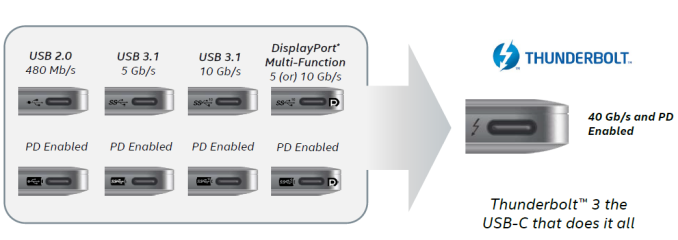
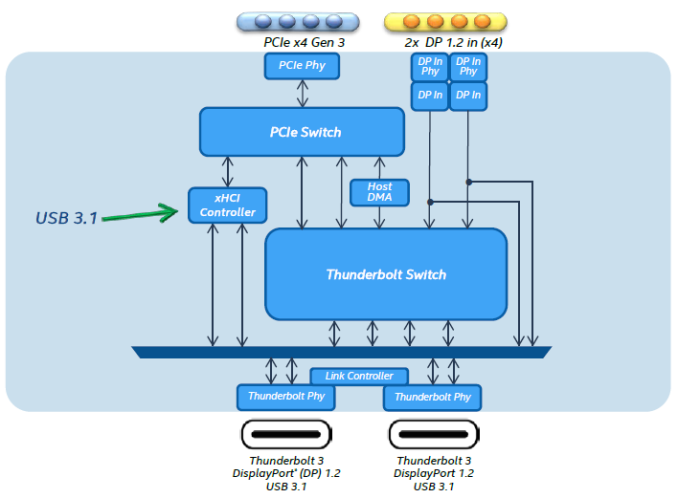
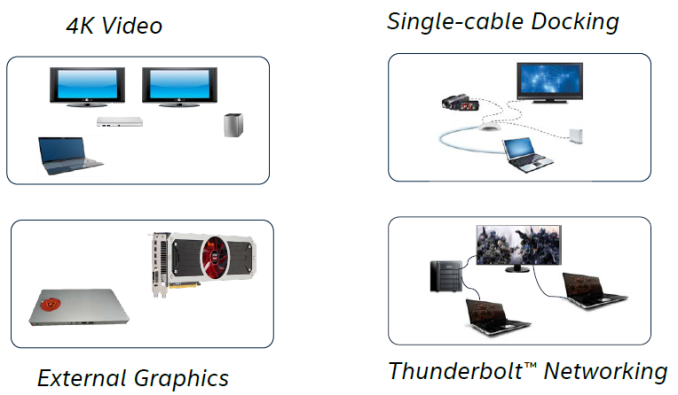








60 Comments
View All Comments
bill44 - Saturday, April 16, 2016 - link
Agreed. If performance is what you seek, this maybe it;https://www.cinema5d.com/faster-than-fast-sonnet-f...
philipma1957 - Saturday, April 16, 2016 - link
I am more of a Mac guy then a Windows or a linux guy.I own 3 macs
I own 3 windows pcs
I own a linux pc
Thunderbolt is all over my home and I use it for a lot of IT work on Macs.
A portable 2 drive piece of gear like this allows for rescue work.
Simply have a ssd in one slot with a mac os and a blank ssd 2tb samsung. go to a clients place
boot with it and then clone and rescue the dead mac's hhd on the big ssd in your other slot.
I do this now with an older version of thunderbolt then this one. Works great.
I have owned a dozen thunderbolt devices and they are day and nigh over most usb3 devices in terms of being a reliable stable external booter. None of this matters to most none mac users.
One of the great features is I can plug in a thunderbolt mac os and boot most macs.
Windows never really allowed this. So to complain about a system like thunderbolt costing too much is okay but the truth is when you realize what thunderbolt 1 and thunderbolt 2 can do to and with someone else's mac you would say that it is too cheap .
LuxZg - Sunday, April 17, 2016 - link
Is it just me or did you really comparr a performance of USB 3.1 Gen.2 SSD connected directly to PC's GEN2 port, vs it connecting to GEN1 port of a DAS and claimed that performance drop is purely due to DAISY CHAINING?ganeshts - Sunday, April 17, 2016 - link
Nope.The USB 3.1 Gen 2 SSD is first connected to a PC's Gen 2 port.
In the second case, it is connected to the Thunderbolt 3 port of the second DAS unit. Note that Thunderbolt 3 can support both Thunderbolt peripherals as well as USB 3.1 Gen 2 devices for daisy chaining. Only obvious restriction is that USB 3.1 Gen 2 devices can appear only at the end of the daisy chain.
Also, please read specifications carefully for the USB 3.1 Gen 1 port of the DAS - The Gen 1 port is a device port - i.e, it can connect to a PC directly. It can't connect to another device like the Extreme 900 Portable SSD.
Zizy - Monday, April 18, 2016 - link
1.) Could you please add USB 3.1 results for direct-attached? (just use USB cable instead of thunderbolt). Presumably the same, right? So, what is the point of Thunderbolt here? Daisy chaining?2.) Temperature is steadily increasing in your test. 10 minutes is quite short-ish test. What is the steady-state temperature and does it throttle at that temperature?
ganeshts - Monday, April 18, 2016 - link
(1) The USB 3.1 port is USB 3.1 Gen 1 - Maximum possible bandwidth on that is theoretically 5 Gbps, but, in practice, for RAID-0 SSDs, one would get around 450 - 500 MBps. So, it will not be the same as that of Thunderbolt 3 - where we could get around 800 MBps(2) Temperature for SSD configuration was with the fans completely turned off. You can see that the fan 'on' case for HDDs shows that even after more than 250GB of continuous data transfer, the temperature of the HDDs is within 5C of the temperature prior to the start of the transfers. I don't expect throttling to be a concern. If it is (depending on the SSD or HDD in use), one should just turn on the fan.
Haravikk - Tuesday, April 19, 2016 - link
Pretty underwhelming for the enormous price; USB3 is fast enough to handle three or even four drives if there's hardware RAID on the other end, so Thunderbolt only really offers an improvement if you're handling a JBOD enclosure, and even then two drives won't really justify it.Also, for the price, why aren't these hot-swap bays? Someone wanting to use paired drives in a mirror setup would benefit from being able to hot-swap in a replacement, and for the money you're spending I'd think that pretty reasonable.
Lastly, couldn't this be bus-powered? Even 3.5" drives shouldn't require so much power the bus can't handle it, plus any good RAID controller should be able to spin them up separately (so you're not drawing peak power for both drives simultaneously).
I dunno, I get that Thunderbolt is still a premium product, but it still feels as though the actual quality of design and features you're getting is severely lacking. Besides, being the first Thunderbolt 3 enclosure for two SATA III drives is meaningless as even Thunderbolt 1 is more than fast enough for that. Even the bigger "high end" enclosures are surprisingly poorly made and thought out for the amount of money you need to drop on them; a networked iSCSI device using ZFS with l2ARC will meet most needs, and the NAS/SAS options are just way better.
Questor - Tuesday, April 19, 2016 - link
I believe computing and related has come to a point where it needs an official organization to manage and assign acronyms.Chad - Tuesday, April 19, 2016 - link
As a thunderbolt user, there are several other benefits (especially for Mac's) that is brings to the table. For example, I added an external HDD, then added 5 more, 1 by 1 as time went on and as needed, for a total of 6, but only using the 1 port. On Mac's, ports are a valuable commodity. On this same iMac, I only had a few USB ports and they were quickly used up for various things. So that left the thunderbolt port... but i was able to connect 5 devices on it. None of them came even remotely close to using it's bandwidth, but for me, it wasn't about that, or about speed... but expandability. That is something worth noting, for sure. Granted, in PC land, this isn't really a concern, but on Mac's, it's a huge thing. There's also an aesthetic factor to daisey chaining, over a spiderweb hub solution.Haravikk - Wednesday, April 20, 2016 - link
True, but my main point was that you're paying a pretty big premium for the Thunderbolt aspect of this device, for what is overall a pretty poor product; two 3.5" bays, not really setup well for 2.5" drives, not hot-swappable, not actually all that compact. Even little things haven't been thought through, like the place of the Thunderbolt ports under the fan, limiting you to a smaller fan size (bigger is always better when it comes to noise after all).Also, technically it's possible to create daisy-chained USB devices too (each one would integrate a three port hub, with one port for whatever it actually does), the only difference with Thunderbolt really is that it's a crucial part of the design so manufacturers are forced to enable chaining, whereas USB device manufacturers are happier cutting their costs and forcing us to rely on hubs.
Also, if I've understood you right and you've got six HDDs, I'd seriously consider an 8-bay NAS instead. If you're fine with command line stuff then you can set that up with ZFS backed iSCSI, format the iSCSI volume as ZFS on your mac and assign it a chunk of your internal drive as a cache, and it's just better overall (if a little complex to setup in the first place). If someone manufactured a Thunderbolt cache device that I could plug straight between a Mac and a NAS then that would be the perfect option, but until then it's big local cache plus NAS with tons of drives for me =)